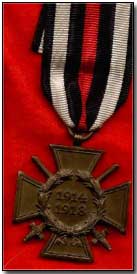Encyclopedia - Cross of Honour 1914-18
 The German Cross of Honour
('Ehrenkreuz 1914-18' in German) was belatedly instituted on 13 July 1934 by
the then-German President
Paul von
Hindenburg - German Army Chief of Staff from 1916 until the close of the
war - as a means of recognising the sacrifices made by German servicemen
from 1914-18.
The German Cross of Honour
('Ehrenkreuz 1914-18' in German) was belatedly instituted on 13 July 1934 by
the then-German President
Paul von
Hindenburg - German Army Chief of Staff from 1916 until the close of the
war - as a means of recognising the sacrifices made by German servicemen
from 1914-18.
The medal, designed by Eugene Godet, comprised a bronze cross made of iron and featured a pair of crossed swords together with the legend '1914-18'.
Three classes of the medal were issued: to combatants, non-combatants and next-of-kin (i.e. widows or parents).
Although available to all servicemen and their widows the Cross of Honour was not automatically issued: it was instead awarded upon application by individuals concerned. In the event it took a lengthy period before the millions of applicants - some eight million in all - all received their medals given that each application had to be individually investigated.
The Cross of Honour was also variously known as the Hindenburg Cross and the Honour Cross of the World War 1914-1918 (in German 'Ehrenkreuz des Weltkrieges 1914-1918').
An Armlet was a cloth band worn around the arm to identify a particular duty or function.
- Did you know?
